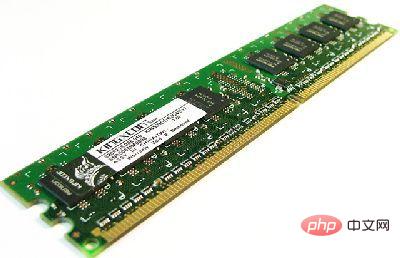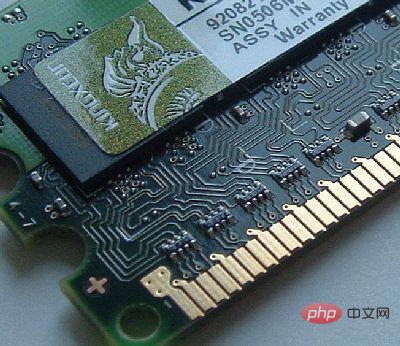 Common Problem
Common Problem
 What is the device used in computers to save the intermediate results and final results of program data operations?
What is the device used in computers to save the intermediate results and final results of program data operations?
What is the device used in computers to save the intermediate results and final results of program data operations?
The device is "memory"; memory is a memory component used to store programs and various data information, and can be divided into two categories: main memory and external memory. Main memory is an important component of computer hardware. Its function is to store instructions and data, and can be directly and randomly accessed by the central processing unit (CPU). The main memory is frequently used by the computer during program execution, and is used during an instruction cycle. Directly accessible. External memory refers to storage other than computer memory and CPU cache. External memory is used to store programs and data that are not in use temporarily. This type of storage can generally still save data after a power outage.

The operating environment of this tutorial: Windows 7 system, Dell G3 computer.
The device used in a computer system to save programs and data, as well as the intermediate results and final results of operations is "memory".
Memory is a memory component used to store programs and various data information. Memory can be divided into two categories: main memory (referred to as main memory or memory) and auxiliary memory (referred to as auxiliary memory or external memory). It is the main memory that directly exchanges information with the CPU.
Main memory
Main memory (Main memory), referred to as main memory. It is an important component of computer hardware. Its function is to store instructions and data, and can be directly accessed randomly by the central processing unit (CPU). Modern computers often adopt multi-level storage systems in order to improve performance while maintaining reasonable costs. That is, a cache memory with small storage capacity and high access speed, and a main memory with moderate storage capacity and access speed are essential. Main memory stores information according to address, and the access speed generally has nothing to do with the address. A 32-bit (bit) address can express a maximum memory address of 4GB. This is sufficient for most applications, but it is not enough for some extremely computationally intensive applications and extremely large databases, which requires a 64-bit structure.

#The main memory works by storing or reading various types of information according to the address of the storage unit, collectively referred to as access memory. The carrier that collects storage units in the main memory is called a memory bank. Each unit in the memory bank can store information represented by a string of binary codes. The total number of bits of this information is called the word length of a storage unit. There is a one-to-one correspondence between the address of the storage unit and the information stored in it. There is only one unit address, which is fixed, but the information stored in it can be replaced.

#The main memory is frequently used by the computer during program execution and is directly accessible during an instruction cycle.
External storage
External storage refers to storage other than computer memory and CPU cache. This type of storage is generally stored after a power outage. Data can still be saved.
External memory requires the computer to read information from an external storage device such as a tape or disk. External memory is used to store programs and data that are not used temporarily.
External memory is usually magnetic media or optical disks, such as hard disks, floppy disks, tapes, CDs, etc., which can store information for a long time and does not rely on electricity to store information, but is driven by mechanical parts and is faster than the CPU It seems much slower.
Floppy disks: Floppy disks use a soft polyester material to make prototype negatives, coated with magnetic material on both surfaces. Commonly used floppy disks have a diameter of 3.5 inches and a storage capacity of 1.44MB. Floppy disks read data through a floppy disk drive.
U disk: U disk is also called "flash disk" and can store data through the USB port of the computer. Compared with floppy disks, U disks have replaced floppy disks due to their small size, large storage capacity, and ease of portability.
Hard disk: The hard disk is composed of an aluminum alloy original plate coated with magnetic material. Each hard disk is composed of several magnetic discs. Among them, solid-state drives are semiconductor memories that use flash memory as the storage medium. Compared with mechanical hard drives, they have advantages such as fast read and write speeds, low latency, and good shock resistance. Their share of shipments in the global hard drive market continues to increase.

The popularity of mobile solid-state drives has greatly reduced the weight of backpacks for people who are accustomed to mobile mechanical hard drives. Moreover, the combination of solid-state and mobile hard drives is obviously in line with the main characteristics of mobile storage products, such as being collision-resistant, lightweight, and plug-and-play without waiting.
Tape memory: Tape is also called sequential access memory SAM. It has a large storage capacity, but the search speed is very slow, and is generally only used as a data back-up store. There are three types of tape drives used in computer systems: reel tape drives, data streaming tape drives, and spiral scan tape drives.
Optical disc storage: Optical disc refers to a disc that uses optical means to store information. It applies optical storage technology, which uses lasers to write information on a certain medium, and then uses lasers to read out the information. Optical disk storage can be divided into: CD-ROM, CD-R, CD-RW, and DVD-ROM, etc.
The difference between memory and external memory
1. Internal memory is a temporary storage area when executing a program. All data will be lost after power-off; external memory is used to store original data and operation results, which need to be saved for a long time. Data will not be lost after power-off.
2. The most prominent feature of internal memory is fast access speed, but small capacity and expensive price; the characteristics of external memory are large capacity, low price, but slow access speed.
3. Internal memory is used to store programs and data that are needed immediately; external memory is used to store programs and data that are not used temporarily.
For more related knowledge, please visit the FAQ column!
The above is the detailed content of What is the device used in computers to save the intermediate results and final results of program data operations?. For more information, please follow other related articles on the PHP Chinese website!

Hot AI Tools

Undresser.AI Undress
AI-powered app for creating realistic nude photos

AI Clothes Remover
Online AI tool for removing clothes from photos.

Undress AI Tool
Undress images for free

Clothoff.io
AI clothes remover

AI Hentai Generator
Generate AI Hentai for free.

Hot Article

Hot Tools

Notepad++7.3.1
Easy-to-use and free code editor

SublimeText3 Chinese version
Chinese version, very easy to use

Zend Studio 13.0.1
Powerful PHP integrated development environment

Dreamweaver CS6
Visual web development tools

SublimeText3 Mac version
God-level code editing software (SublimeText3)

Hot Topics
 1378
1378
 52
52
 2024 CSRankings National Computer Science Rankings Released! CMU dominates the list, MIT falls out of the top 5
Mar 25, 2024 pm 06:01 PM
2024 CSRankings National Computer Science Rankings Released! CMU dominates the list, MIT falls out of the top 5
Mar 25, 2024 pm 06:01 PM
The 2024CSRankings National Computer Science Major Rankings have just been released! This year, in the ranking of the best CS universities in the United States, Carnegie Mellon University (CMU) ranks among the best in the country and in the field of CS, while the University of Illinois at Urbana-Champaign (UIUC) has been ranked second for six consecutive years. Georgia Tech ranked third. Then, Stanford University, University of California at San Diego, University of Michigan, and University of Washington tied for fourth place in the world. It is worth noting that MIT's ranking fell and fell out of the top five. CSRankings is a global university ranking project in the field of computer science initiated by Professor Emery Berger of the School of Computer and Information Sciences at the University of Massachusetts Amherst. The ranking is based on objective
 Remote Desktop cannot authenticate the remote computer's identity
Feb 29, 2024 pm 12:30 PM
Remote Desktop cannot authenticate the remote computer's identity
Feb 29, 2024 pm 12:30 PM
Windows Remote Desktop Service allows users to access computers remotely, which is very convenient for people who need to work remotely. However, problems can be encountered when users cannot connect to the remote computer or when Remote Desktop cannot authenticate the computer's identity. This may be caused by network connection issues or certificate verification failure. In this case, the user may need to check the network connection, ensure that the remote computer is online, and try to reconnect. Also, ensuring that the remote computer's authentication options are configured correctly is key to resolving the issue. Such problems with Windows Remote Desktop Services can usually be resolved by carefully checking and adjusting settings. Remote Desktop cannot verify the identity of the remote computer due to a time or date difference. Please make sure your calculations
 What is e in computer
Aug 31, 2023 am 09:36 AM
What is e in computer
Aug 31, 2023 am 09:36 AM
The "e" of computer is the scientific notation symbol. The letter "e" is used as the exponent separator in scientific notation, which means "multiplied to the power of 10". In scientific notation, a number is usually written as M × 10^E, where M is a number between 1 and 10 and E represents the exponent.
 Fix: Microsoft Teams error code 80090016 Your computer's Trusted Platform module has failed
Apr 19, 2023 pm 09:28 PM
Fix: Microsoft Teams error code 80090016 Your computer's Trusted Platform module has failed
Apr 19, 2023 pm 09:28 PM
<p>MSTeams is the trusted platform to communicate, chat or call with teammates and colleagues. Error code 80090016 on MSTeams and the message <strong>Your computer's Trusted Platform Module has failed</strong> may cause difficulty logging in. The app will not allow you to log in until the error code is resolved. If you encounter such messages while opening MS Teams or any other Microsoft application, then this article can guide you to resolve the issue. </p><h2&
 What does computer cu mean?
Aug 15, 2023 am 09:58 AM
What does computer cu mean?
Aug 15, 2023 am 09:58 AM
The meaning of cu in a computer depends on the context: 1. Control Unit, in the central processor of a computer, CU is the component responsible for coordinating and controlling the entire computing process; 2. Compute Unit, in a graphics processor or other accelerated processor, CU is the basic unit for processing parallel computing tasks.
 Unable to open the Group Policy object on this computer
Feb 07, 2024 pm 02:00 PM
Unable to open the Group Policy object on this computer
Feb 07, 2024 pm 02:00 PM
Occasionally, the operating system may malfunction when using a computer. The problem I encountered today was that when accessing gpedit.msc, the system prompted that the Group Policy object could not be opened because the correct permissions may be lacking. The Group Policy object on this computer could not be opened. Solution: 1. When accessing gpedit.msc, the system prompts that the Group Policy object on this computer cannot be opened because of lack of permissions. Details: The system cannot locate the path specified. 2. After the user clicks the close button, the following error window pops up. 3. Check the log records immediately and combine the recorded information to find that the problem lies in the C:\Windows\System32\GroupPolicy\Machine\registry.pol file
 What should I do if steam cannot connect to the remote computer?
Mar 01, 2023 pm 02:20 PM
What should I do if steam cannot connect to the remote computer?
Mar 01, 2023 pm 02:20 PM
Solution to the problem that steam cannot connect to the remote computer: 1. In the game platform, click the "steam" option in the upper left corner; 2. Open the menu and select the "Settings" option; 3. Select the "Remote Play" option; 4. Check Activate the "Remote Play" function and click the "OK" button.
 Python script to log out of computer
Sep 05, 2023 am 08:37 AM
Python script to log out of computer
Sep 05, 2023 am 08:37 AM
In today's digital age, automation plays a vital role in streamlining and simplifying various tasks. One of these tasks is to log off the computer, which is usually done manually by selecting the logout option from the operating system's user interface. But what if we could automate this process using a Python script? In this blog post, we'll explore how to create a Python script that can log off your computer with just a few lines of code. In this article, we'll walk through the step-by-step process of creating a Python script for logging out of your computer. We'll cover the necessary prerequisites, discuss different ways to log out programmatically, and provide a step-by-step guide to writing the script. Additionally, we will address platform-specific considerations and highlight best practices


